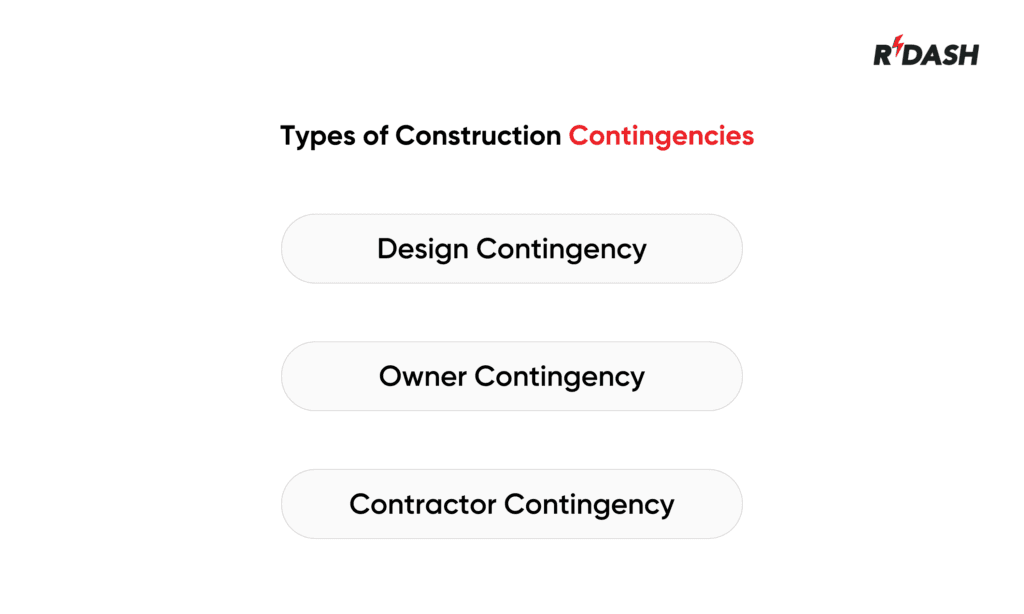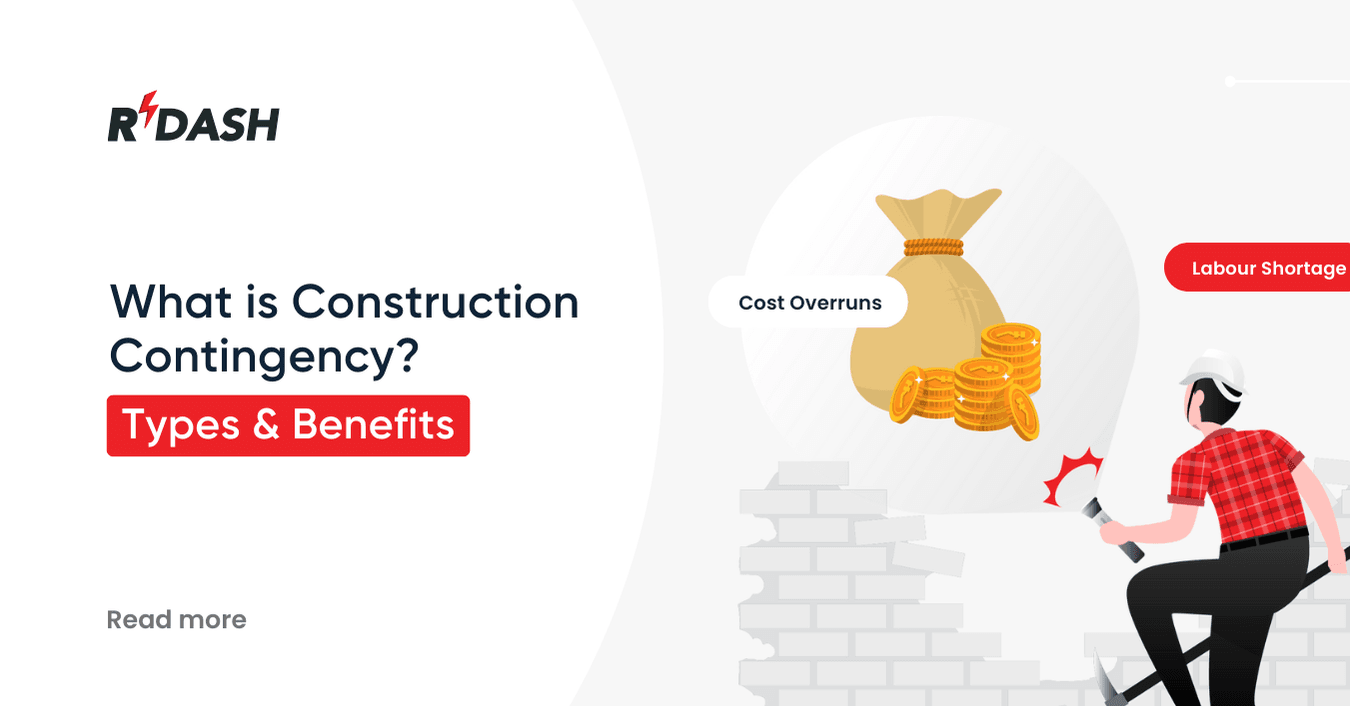What is a Contingency in Construction?
In construction, a contingency refers to a sum of money included in the project budget to account for unforeseen expenses. These costs are not part of the initial estimate but may emerge during the course of the project.
Construction projects often face surprises—such as design changes, errors, material delays, or unexpected site conditions. A contingency helps manage these risks without affecting the overall project budget or timeline. It is a safety net that helps contractors and owners stay prepared for the unknown.
What are the Different Types of Construction Contingency?
Here are the main ones:

1. Design Contingency
This is used during the early stages of a project, especially when the design is not fully complete. Since many details are still being worked out, the design contingency helps cover any changes or updates needed in the drawings or specifications.
It protects the project from cost increases as the design gets more detailed.
2. Owner Contingency
This amount is allocated by the project owner. It gives the owner flexibility to make changes during the construction process, such as adding new features, upgrading materials, or responding to delays.
It also helps cover unexpected costs that were not part of the original contractor’s scope of work. The owner manages this contingency and determines how and when it will be utilized.
3. Contractor Contingency
This is included in the contractor’s budget to cover unknown risks or minor mistakes during construction. It might be used for labor shortages, small errors, or changes in material prices.
Contractors usually don’t need approval from the owner to use this fund, but they must still manage it carefully. It helps ensure that the project stays on schedule and within budget, even when small surprises happen on site.
Benefits of Using Construction Contingency
Construction projects consist of various components – labor, materials, weather, and timelines. Despite careful planning, unforeseen issues can still arise. That’s where construction contingencies come in. A contingency is a reserved amount of money or time set aside to deal with surprises that were not part of the original plan.
Here’s why having construction contingencies is so important:
1. Helps Manage Unexpected Costs
No matter how carefully you plan a project, there are always risks. Costs may go up due to price changes in materials or delays in supply. A contingency fund helps cover these costs without putting pressure on the overall project budget. This allows the project to move ahead without needing extra approvals or stopping work.
2. Keeps the Project on Track
Delays caused by labor shortages, late deliveries, or bad weather can push deadlines. With a contingency in place, project managers can take quick action—such as hiring more workers or renting extra equipment—to keep the schedule on track. This reduces the risk of the project missing important milestones.
3. Reduces Disputes Between Stakeholders
When something goes wrong, teams often spend time figuring out who will bear the cost. This can lead to confusion, disagreements, and even delays. A clearly defined contingency removes that uncertainty. Everyone knows how unexpected costs will be handled, creating better teamwork and smoother project management.
4. Builds Stakeholder Confidence
Clients, investors, and contractors all feel more secure when a contingency plan is in place. It shows that the team has thought about possible risks and is prepared to handle them. This increases trust and gives everyone confidence in the project’s success.
5. Improves Overall Project Planning
Having a contingency plan makes project teams more disciplined. They are encouraged to identify risks early, prepare for them, and avoid common mistakes. This leads to better overall planning and stronger project outcomes.
Examples of Construction Contingency
Here are a few real-world examples of where contingencies play a key role in construction:

1. Material Shortage Contingency
Imagine you’re building a commercial office and the supplier suddenly runs out of a key material like cement or steel. Prices may rise if you need to buy from a different vendor. A material shortage contingency helps cover these increased costs without impacting your budget or delaying progress.
2. Labor Shortage Contingency
If skilled laborers go on strike or fall ill, it may affect daily work. This can be especially risky in large projects with tight deadlines. A labor contingency gives you the flexibility to hire temporary workers or pay overtime, keeping the project on schedule.
3. Weather Contingency
Heavy rains, storms, or heatwaves can delay construction—especially when outdoor work is involved. A weather contingency ensures that money is available for rescheduling labor, extending equipment rentals, or protecting materials. This prevents serious financial or time setbacks.
Why Are Construction Contingency Important?
Construction projects are full of surprises. Even with careful planning, things don’t always go as expected. Costs can go up, timelines can shift, and unforeseen problems can occur. That’s why having a construction contingency is important.
A contingency is a portion of money or time set aside to address unforeseen changes or risks that may occur during a project. It serves as a safety cushion, helping to keep the project on track when unexpected problems emerge.
Here’s why construction contingencies are so important:
1. They Help Manage Risk
No project can predict everything. Materials may become more expensive, labor might be delayed, or weather could interrupt work. A contingency helps you manage these risks without affecting the main project budget.
2. They Prevent Delays
When unexpected issues come up, it takes time to find a solution. With contingency funds already in place, project managers can act quickly. This reduces delays and keeps the project on schedule.
3. They Reduce Financial Stress
Without a contingency, teams may need to request more money from the client or cut corners. This creates stress and can lead to poor-quality work. A contingency avoids this by giving room to handle extra costs without panic.
4. They Build Trust
Clients and stakeholders feel more confident when they know there’s a plan for handling surprises.Having contingencies in place demonstrates the team’s readiness, fostering trust and ensuring alignment across the board.
5. They Improve Project Planning
By adding contingencies to your plan, you are forced to think ahead about possible risks. This leads to better planning and fewer problems during the actual construction work.
Is Contingency the Same as Retainage?
No, contingency and retainage are not the same—they serve very different purposes in construction.
- A contingency fund is allocated to address unforeseen expenses or adjustments that may arise during the project. It is part of the planned expenses and is used as needed.
- Retainage, on the other hand, is a portion of the payment (usually 5–10%) that is held back by the client until the project is fully completed.It helps guarantee that the work is completed efficiently and within the specified timeline. The contractor receives the retained amount only after final approval.
So while both involve money set aside during the project, contingency is for surprises, and retainage is for quality assurance.
Tips for Using Construction Contingency
Construction contingencies are not just about setting aside money – they’re about using it wisely. Whether you’re a contractor, project manager, or building owner, knowing how to manage contingency funds is important for keeping your project on track and within budget.
Here are some helpful tips for using construction contingencies effectively:
1. Plan Ahead
Make sure to factor in a contingency reserve in your budget from the outset. Don’t wait for problems to occur – expect the unexpected. This way, you’re prepared without affecting your main budget.
2. Set Clear Rules
Make sure everyone involved in the project knows how the contingency can be used. Define which types of issues the money can cover—like design changes, material delays, or weather problems.
3. Track Every Use
Every time you use part of the contingency fund, record it. This helps you stay aware of how much is left and avoid overspending.
4. Get Approvals
Don’t use the contingency without approval. Having a simple approval process makes sure the money is only spent when necessary.
5. Review Regularly
Check your contingency fund regularly during the project. Are you using it too fast? Is it enough to cover future risks? Reviewing helps you stay in control.
How to Use the Contingency Budget
Using the contingency budget should be done carefully and only when truly needed. Here’s a simple process to follow:
- Identify the Issue
When an unexpected cost or delay comes up, check if it qualifies for contingency use. - Estimate the Cost
Calculate how much extra money or time is needed to solve the problem. - Request Approval
Inform the project manager or decision-maker and ask for approval to use the contingency. - Document Everything
Keep records of why the money was used, how much was spent, and what outcome it achieved. - Update the Budget
After using the funds, update your budget and note the remaining contingency amount.
This keeps the project organized and avoids confusion later.
FAQs
How much contingency should be allocated to a project?
The amount varies based on the project’s size and nature. Typically, 5–10% of the total project cost is reserved for contingencies.
Who controls the contingency budget?
It can be managed by the project manager, contractor, or client—depending on the agreement.
Can contingency money be used for anything?
No. It should only be used for unplanned, necessary costs—not for extras or upgrades unless approved.
What if we don’t use the contingency?
If the contingency is not utilized, it can either be refunded to the client or kept for future use, depending on the terms of the contract.
Is contingency the same as extra budget?
A contingency is a designated fund to address potential risks. An extra budget usually refers to added funds not included in the original plan.






